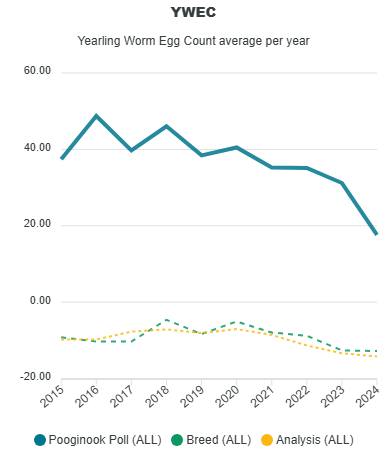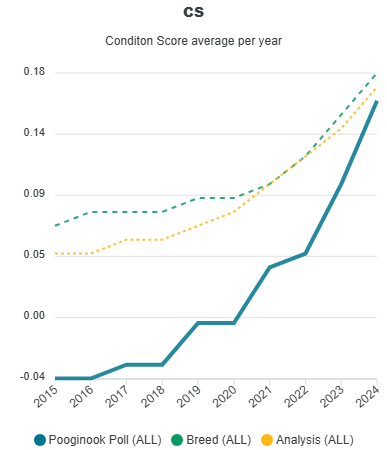Resilience & Efficiency
Targeted traits:
Worm Resistance, Dag Score, Condition, Breech Cover
Overview
This pillar targets the traits that reduce time in the drenching race and lift whole-flock resilience. We’re building sheep that require fewer treatments, hold their condition under pressure, and perform with less labour — especially in tough seasons or low-input systems.
By selecting for worm resistance, breech traits, and condition score, we’re aiming to reduce flystrike risk, lower dag load, and improve survivability. The goal isn’t just low-maintenance sheep — it’s high-survival, high-welfare sheep that stay productive with less intervention.
1. Yearling Worm Egg Count (YWEC)
YWEC measures a sheep’s natural resistance to internal parasites, based on the number of worm eggs present in faecal samples. It’s one of the most impactful traits for reducing drench use, improving animal health, and lifting long-term productivity in pasture-based systems.
At Pooginook, we’re selecting strongly against high worm egg counts, aiming for an ASBV of -25 by 2030. By breeding for improved parasite resistance, we’re helping clients build flocks that are easier to manage, more resilient in high-challenge environments, and less reliant on chemical inputs.
2. Late Dag Score (LDAG)
Dag score reflects how much faecal soiling builds up around the breech area — a key factor in labour, flystrike risk, and overall animal welfare. LDAG specifically measures this trait later in the season, when fly pressure is typically higher and dag load has the greatest impact.
At Pooginook, we’re actively reducing dag scores to lower the need for crutching, minimise fly treatments, and support low-input management. Our 2030 target is to drive dag scores below -0.5 flock average — helping producers save time, reduce chemical use, and improve whole-flock presentation.
3. Breech Wrinkle (EBWR)
Breech wrinkle is a key risk factor for flystrike. More wrinkle around the breech means more moisture retention, increased soiling, and a higher chance of flystrike — especially during wet or humid periods. Reducing wrinkle leads to lower risk and less reliance on surgical or chemical intervention. Without compromising fleece weight, while improving growth rates, fertility, improved resilience.
At Pooginook, we’re breeding for naturally plainer breeches without compromising structure. Our 2030 target is to consistently reduce EBWR to below -0.8, helping clients move away from mulesing and toward simpler, lower-risk sheep that hold up under pressure.
4. Breech Cover (EBCOV)
Breech cover refers to the amount of wool covering the breech area. Too much cover can trap moisture and increase flystrike risk, while too little can expose the skin to UV damage and irritation. The goal is a naturally balanced breech that provides protection without creating problems.
At Pooginook, we’re selecting for optimal breech cover to support flystrike resistance without intervention. Our 2030 target is to reduce breech cover to below -0.3 flock average — helping producers manage animal health and compliance without compromising fleece structure or paddock resilience.
5. Condition Score (CS)
Condition Score is a hands-on measure of a sheep’s ability to maintain fat and muscle reserves — especially during times of feed stress, high workload (like lactation), or seasonal variation. Higher scores typically reflect better do-ability, fertility, and long-term survivability.
At Pooginook, we’re selecting for ewes that hold condition under pressure. Our 2030 target is to lift flock average condition score above +0.3 — producing sheep that keep doing their job with less input, even in challenging environments.
In Summary
Resilience and efficiency aren’t just about surviving — they’re about performing with less. At Pooginook, we’re focused on breeding sheep that resist parasites, reduce labour, and stay productive through seasonal challenges. By lifting condition score, reducing breech issues, and lowering dag and worm load, we’re building a flock that fits the future — low-input, high-survival, and easier to manage without compromise.

Keep Exploring.
Every trait you’ve just read about is part of a bigger picture. If you’re ready to dive deeper, compare your own data, or see how it all connects — keep going.
There’s more to learn, more to apply, and our team’s here to guide you through it.





